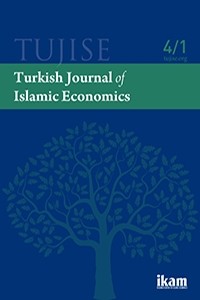HURŞİD AHMET’İN İKTİSAT DÜŞÜNCESİ
Hurşid Ahmet günümüz İslam Dünyasının en parlak yazarlarından biridir. Gerçekten, hem Batı hem de İslam dünyasında elde ettiği tanınırlığı, onun dünya çapında bir entellektüel olduğunu göstermektedir. Hurşid, akademik kariyerinin erken döneminden beri sınırları aşan tanınırlığa sahip dersleri, editörlük faaliyetleri, konuşmaları, diyalogları ve seminerlerinde insanlığın problemlerine çözüm olarak İslami reformları tavsiye ediyordu. Çağdaş İslam iktisatçıları, ananevi iktisatçılar ve diğerleri kadar çok yazmamasına rağmen, ürettikleri ikna edicidir ve entellektüel kapasitesini göstermektedir. Bazı spesifik meseleleri geçmişdekilere dayandırarak haklı çıkarmaya çalışan ve çalışmaları sadece teorik kalan, pratik uygulamaya elverişli olmayan veya İslam dünyasında önemli bir akım doğurmayan İslam hukukçuları ve çağdaş İslam iktisatçılarından farklı olarak Hurşid, İslam iktisadını uygulamalı bir disiplin olarak geliştirmek için sistematik bir teşebbüsle ilerledi. Bu makale, onun modern zamanlardaki İslam iktisat düşüncesine olan katkısını, onun İslam iktisadı kavramına odaklanarak ortaya koymaya çalışmaktadır. Anahtar kelimeler: İslam iktisadı, modern gelişme, tarih, Hurşid Ahmet, İslam iktisatçıları
Anahtar Kelimeler:
İslam iktisadı, modern gelişme, tarih, Hurşid Ahmet, İslam iktisatçıları
THE ECONOMIC THOUGT OF KHURSHID AHMAD
Khurshid Ahmad is one of the pre-eminent writers of contemporary Islamic world. Indeed, the recognition he has received from Western as well as Islamic world testifies to his stature as world intellect figure. Khurshid is advocating the Islamic reforms as a remedy for all the human problems since his very early academic career lectures, editorial work, speeches, dialogues and seminars which have recognized beyond boundaries. Though he has not written as extensively as many others, contemporary Islamic and conventional economist did, whatever he produced is convincing and reflects his intellectual capability. Unlike others legists and thinkers of contemporary Islamic economics, those merely attempted to justify the specific cases on the basis of precedent and their works are only theoretical and have never been recognized for practical implications or could not brought significant movement in the Islamic world, Khurshid had developed a systematic attempt for developing Islamic economics as an applied discipline. This paper attempts to highlight his immense contribution towards Islamic economic thought in the modern times focusing on his perception of Islamic economics.Keywords: Islamic economics, modern development, history, Khurshid Ahmad, Islamic economist
___
- Ahmad, Khurshid. (1970). The Religion of Islam. Lahore: Islamic Publication.
- Ahmad, Khurshid (1979). Economic Development in an Islamic Framework. Leicester: Islamic Foundation.
- Ahmad, Khurshid (1981). Towards the Monetary and Fiscal System of Islam, A Personal Report on Some Pertinent Questions and Seminar’s Response to them, Based on Seminar on Monetary and Fiscal Economics of Islam, held in Islamabad on 6-10 January 1981.
- Ahmad, Khurshid (1986). Keynote Address, In Zia ud din Ahmed, Munawar Iqbal and Khan F. (eds.), Fiscal Policy and Resource Allocation in Islam, Islamabad: Institute of Policy Studies.
- Ahmad, Khurshid. (1993). Islami Nazriya-e-Hayat (Islamic Vision of Life). Karachi: Karachi University.
- Ahmad, Khurshid. (1994). Islamic Approach to Development: Some Policy Implications. Islamabad: Institute of Policy Studies.
- Ahmad, Khurshid. (1995). Elimination of Riba: Concept and Problems. In Khurshid Ahmad (ed.), Elimination of Riba from the Economy, Islamabad: Institute of Policy Studies.
- Ahmad, Khurshid (1997). Poverty in the World: Some Points to Ponder. In Mohib ul Haq Sahibzada (ed.) Poverty Alleviation in Pakistan. Islamabad: Institute of Policy Studies.
- Ahmad, Khurshid. (2006). Speech at the 22nd Convocation Ceremony, on the occasion of the conferment of the Honorary Degree of Doctor of Philosophy (Islamic Economics) at Kuala Lumpur (August 26–27, 2006).
- Hassan, Mehboob (2010). Islamic Approach of Economics. Kyoto Bulletin of Islamic Area Studies, 3 (2). pp. 216-240.
- Başlangıç: 2014
- Yayıncı: Research Center for Islamic Economics (ikam)
Sayıdaki Diğer Makaleler
SUKUK FİNANSMANI İKTİSADİ BÜYÜMEYİ TEŞVİK EDER Mİ? SUKUK ÇIKARAN ANA ÜLKELER ÜZERİNE BİR ÇALIŞMA
Abdelghani ECHCHABI, Hassanuddeen ABD.AZIZ, Umar IDRISS
RİBA (FAİZ); FİNANSAL İŞLEMLERDEN ÇIKARILMASI GEREKEN BİR ARAÇ
HURŞİD AHMET’İN İKTİSAT DÜŞÜNCESİ
İSLAM HUKUKUNDA HAYAT SİGORTASINA YENİDEN BAKIŞ
PİYASALARIN AYRIŞMASI VE MALİ İSTİKRARSIZLIK: KLASİK DİKOTOMİYE YAKIN BİR BAKIŞ
